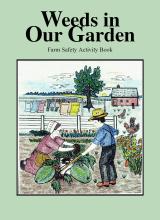Indiana Ag Safety & Health History
For a more comprehensive summary of Indiana agricultural safety and health history
and the Purdue Safety & Health Program visit the link below.
40’s – 70’s
Early Agricultural Heath and Safety Efforts
For the first three decades, the PUASHP thrived under the leadership of Professor F.R. (Dick) Willsey who was recognized as a premier example of the traditional Extension education specialist. He traveled extensively, including by train, promoting farm safety wherever he could gain an audience. He was innovative in the use of safety plays and skits, audiovisual materials, demonstrations, and dynamic exhibits.
Formation of the FarmSafety Committee
A meeting was held at Purdue University in 1942 to address the high frequency of farm-related injuries and fatalities and their impact on wartime food production efforts.
Hiring F.R. Willsey
F.R Willsey, a navy veteran, was hired in 1945 to become the state’s first Farm Safety Leader. He was located in the Agricultural Engineering Department, and held the position for over 30 years, retiring in 1976.
Community-based Theater
Lorem ipsum dolor sit amet, consectetur adipiscing elit, sed do eiusmod tempor incididunt ut labore et dolore magna aliqua. Ut enim ad minim veniam, quis nostrud exercitation ullamco laboris nisi ut aliquip ex ea commodo consequat.
Support Groups
Lorem ipsum dolor sit amet, consectetur adipiscing elit, sed do eiusmod tempor incididunt ut labore et dolore magna aliqua. Ut enim ad minim veniam, quis nostrud exercitation ullamco laboris nisi ut aliquip ex ea commodo consequat.
Agricultural Safety Repository
During the 1960s, the Agricultural Engineering Building became a repository of educational resources related to the risks to agriculture from nuclear/radioactive fallout. The stockpile included a large number of Geiger Counters and plans for building fall-out shelters.
William E. (Bill) Field
In 1977, William E. (Bill) Field replaced Professor Willsey who had retired the previous year. Building on the work started by Professor Willsey, with his continued support, Professor Field became heavily involved in coordinating and promoting local agricultural safety activities throughout the state.
80’s
Early Agricultural Heath and Safety Efforts
Starting in 1977, William E. (Bill) Field replaced Professor Willsey, who had retired the previous year. Building on the work started by Professor Willsey, with his continued support, Professor Field became heavily involved in coordinating and promoting local agricultural safety activities throughout the state. He sought to involve as many groups as possible in program efforts, including Farm Bureau, 4-H, FFA, Extension Homemakers, insurance companies, implement dealers, and community organizations.
William E. (Bill) Field
In 1978, Professor Field made his first international trip as a Purdue faculty member to St. Lust, Guyana, where he learned about the hazards of rainforest farming practices that included giant spiders and venomous reptiles.
First Undergraduate Class
Professor Field developed both undergraduate classes (ASM 350), which has exposed thousands of students to the field of agricultural safety and health.
First Graduate Program
Professor Field’s coordination of graduate-level research resulted in awarding of nearly 45 graduate degrees in the field and dozens of research reports and published works that have contributed substantially to the current body of knowledge.

The first Ph.D. graduate of Purdue’s Agricultural Safety and Health Program, under Professor Field was Roger Tormoehlen, who served as a Department Head at Purdue for 11 years.
Contributing to Making Chinese Farm Equipment Safer
Professor Field spent two summers (1982 and 1984) in Luoyang, China, working at the Chinese Tractor Research Center, teaching English to engineers and contributing to making Chinese farm equipment safer. The use of machine guarding was almost non existent at the time.
90’s
Accomplishments and Initiatives During the 1990s
The agricultural safety and health information dissemination in the 90s included several short films, family-oriented coloring & activity books, and a series of safety-related websites. In addition to dissemination efforts, for more than 25 years, the Indiana Department of Health and Purdue worked together to identify reports of farm-related deaths and suicides involving Indiana “farm residents,” addressing the quality of agricultural injury data available for analysis.
Arability Program

Over 250,000 copies of Careful Country, a family-oriented coloring and activity book promoting farm safety, were distributed from the back of the original ABE Building.

In 1996, in response to the growing number of farm-related fatalities and injuries in Amish and Old Order communities, Purdue worked in conjunction with the Indiana Rural Safety and Health Council and The Northern Indiana Family Safety Committee to produce Weeds in Our Garden. This child-oriented coloring and activity book was designed specifically for use by Amish children.
Sharing the Road
Over 35,000 copies have been distributed nationally. A second publication on Amish buggy safety, Sharing the Road, was developed with support from the Governor’s Task Force on Impaired and Dangerous Driving. Over 70,000 copies were circulated to Amish communities nationwide for distribution to non-Amish motor vehicle operators.
farmsafety.org
One of the first websites on farm safety resources for children (farmsafety.org) was established in 1995 by Purdue in cooperation with the Indiana Rural Safety and Health Council. This has been expanded regularly to include new resources and links with other programs. In 2001, the site received a national educational award from ASABE.
00’s
Early Agricultural Heath and Safety Efforts
In 2002, a new series of presentations on emergency preparedness for agricultural production sites were developed and field tested with farm operators. In 2003 the material was offered as a pilot three credit graduate-level course in Agricultural and Biological Engineering (ASM 510 Agrosecurity). This class is designed to assist future agricultural managers in preventing, preparing for, responding to, and recovering from both natural and man-made disasters. The class involves a service learning project that requires students to develop an emergency response plan for an agricultural production site.
In 2006 with support from the Indiana Department of Homeland Security, PUASHP staff participated in developing two graduate-level classes dealing with the foundations and applications of homeland security. These two courses have been team taught each year since 2007, with faculty from several departments exposing hundreds of Purdue students to career opportunities in the field of emergency preparedness and response.
